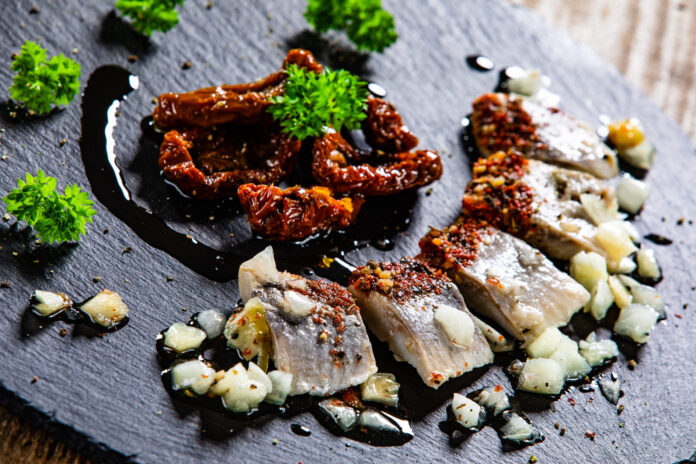
Anyone with roots in Northern or Eastern Europe are familiar with herring, served on any occasion as an appetizer, but especially featured at Christmas. Rare is the Christmas Eve (Kūčios) table without some form of this unique fish.
It was second nature for our mothers and grandmothers to bring whole herrings home from the local deli, fresh from the barrel, and roll up their sleeves to dress, soak, skin, fillet and pluck any lingering bones from this odorous delicacy, far more appetizing once presented in a duvet of sour cream, mushrooms or tomato sauce. It can be done without great pain, but it is much easier if you have a handy fishing aficionado who knows his or her way around a fillet knife. Easiest of all, of course, is having a favourite deli brand of herring to rinse and use with your own finishing touches. It comes frozen in fillets, vacuum packed in oil, or cut up and marinated in jars with onions and other add-ins, depending on your supplier’s stock.
Although the health benefits of herring as a source of Omega-3 fats are well known, they don’t convince everyone. Usually guests at the Kūčios table fall into two camps. There are those who love herring, and ask it to be sent down the table repeatedly, together with your best “black bread”, and the others, whose nose-wrinkling shows their complete intolerance, especially among the younger set. Of course, they’re also not as interested in heart-healthy foods. It’s true, the sodium used in pickled herring is often excessive: Lithuanian experts recommend soaking herring in water, tea or milk.
The most common presentation for herring uses combinations of onions, mushrooms, boiled eggs, beets, carrots, a marinade or sour cream. There are many good recipes online. One interesting but straightforward variation has the pieces covered in caramelized onions mixed with dried cranberries.
A more novel approach was offered on alkas.lt recently, and involves sun-dried tomatoes. The amounts are approximate – a) because few cooks in North America use grams, and b) most Lithuanian cooks use ingredients according to taste: “pagal akį”.
You will need:
80 g sun-dried tomatoes (about 3 oz.) in oil
400 g herring in oil (14 oz.)
1 thinly sliced onion
2 tablespoons mustard
3 tablespoons sunflower oil
Dash pepper
1 tablespoon balsamic vinegar
4 tablespoons oil from the sun-dried tomato jar
- Place sliced onion in colander and scald with hot water; allow to cool.
- Pat herring dry with paper towels and cut into one-inch pieces.
- Slice the tomatoes in strips, add to sliced herring and cooled onion.
- In a separate bowl, mix sunflower oil, pepper, balsamic vinegar and mustard, add to herring mixture, mix and chill for at least two hours.
Skanaus!





























